Last Tuesday evening we spent a most enjoyable and informative evening at Mike Wilson’s hockey museum in Toronto with three iconic on-ice officials from the National Hockey League’s recent past. Bruce Hood, Ron Wicks and Bryan Lewis regaled the assembled group of hockey writers, historians and enthusiasts with stories of “the good old days” and their impressions on today’s game.
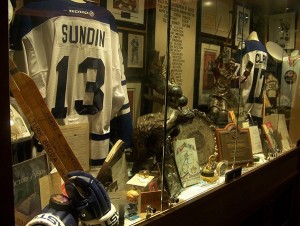
The subjects ranged from the best and toughest players ever, to comparisons between today’s game and the game when these gentlemen were officiating.
Three very proud individuals
As the evening began, several things became readily apparent. These three men, now years removed from the ice wars, were, and still are, true professionals. Each of them, despite very diverse personalities, demonstrated a fierce love for the sport for which they hold such a high regard. And, to a man, they are each extremely proud of the work they did in the NHL.

Something else that might be surprising to the casual observer is the fact that these men were athletes, just as much as the players they officiated. Each of them, despite their comparatively advanced years is still in tremendous shape. Bryan Lewis, youngest of the three, still looks like he could lace up the blades and control a game.
Background
Bryan was born in 1942 in Alliston, Ontario. He began refereeing in the NHL during the 1966-67 season, and handled over 1000 games in his career. His on-ice work in the league ended when he was named the NHL’s Director of Officiating in 1989.

Ron Wicks, 75, is still the youngest man to ever officiate a National Hockey League game, doing so in 1960 and the tender age of 20. All told, he wore the striped shirt for over 1, 400 NHL games, plus another 175 in the Stanley Cup playoffs. He worked in five Stanley Cup final series. He is still the longest-serving official, having been on the ice in the NHL for 26 years.
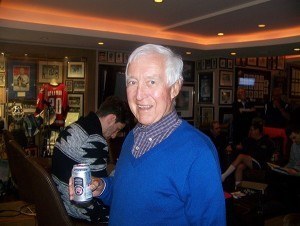
Bruce Hood is 79 years old, hailing from Campbellville, Ontario. He officiated 1,033 NHL games, along with 157 playoff games. He was the last NHL official to wear the number one, and was also instrumental, along with the other two guests, in forming the NHL Officials Association in 1969.
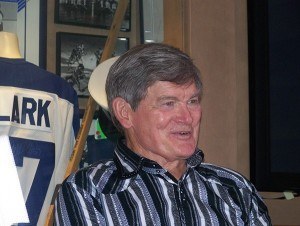
The panel discussion began with a video montage of some of the more famous moments in refereeing history. One of the more recent events, the disputed Brett Hull overtime goal in Buffalo that gave Dallas it’s only Stanley Cup, was shown.
Bryan Lewis was the Director of Officiating for the NHL at the time. He provided a concise and logical explanation as to why the goal was legal within the rules of the day. He quoted the rule book word-for-word (just as one would expect an experienced official to do) and left no doubt (much to the chagrin of Sabres fans everywhere) that the goal was, as they say, a good hockey goal.
Lewis: “Better than delivering newspapers”
All three men started out playing hockey. Lewis took up officiating to earn extra money, and then graduated to the OHA. Pat Patterson, then the OHA referee-in-chief, told him he had to do two things to get into the OHA: “Pull up your pants and get a hair cut.”
Bryan said, “It ended up being better than delivering newspapers.”
Wicks scouted by Leafs’ Bob Davidson
Ron Wicks grew up in Sudbury, playing defence until he graduated from midget hockey. They had trouble getting officials for games, so he got involved to keep the kids’ hockey going.
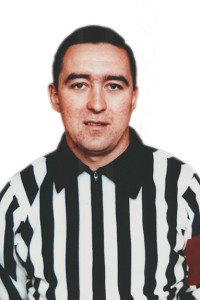
Toronto Maple Leaf scout Bob Davidson saw Ron referee some games and sent his name to Carl Voss, the NHL referee-in-chief at the time. Ron took two weeks off from his job as a Sudbury tax assessor and went south to do a few exhibition games, whereupon he was hired by the NHL at the tender age of 20.
When asked if anyone has or could best his record as the NHL’s youngest official, he said, “They don’t hire them that age any more, and they wouldn’t come that cheap!”
“Elmer Vasko got me into the big leagues”
Ron talked about his first exhibition game, which took place in Peterborough. He said that he was sitting in the lobby of the hotel when Elmer Vasko came up and asked him where he was from and what he was doing. Ron explained that he was from Sudbury and was trying to make the NHL as a referee. Vasko wished him luck.
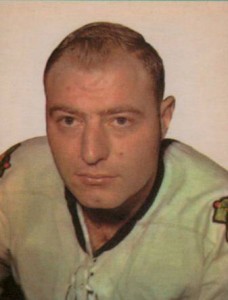
That night during the game, a brawl broke out, and Vasko was involved. At the time Vasko was the NHL’s biggest man, and Ron is not a particularly large person. He went up to Vasko and asked him to go to the penalty box.
Vasko recognized him and smiled and said, “You know, you’re right, kid” and proceeded to the sin bin.
Carl Voss was at the game and came up to him later and commended him on how he broke up the fight. That is why Ron credits Elmer Vasko for getting him into the NHL.
“So the next time I saw Mr. Vasko, I bought him a cold beer. He got me into the big leagues.”
Hood: Referee by accident
Bruce Hood’s start in officiating was quite by accident. He was playing intermediate and senior hockey in Milton and also worked at the Milton arena. One night in the local junior farmer’s league, a referee didn’t show up. The teams asked Bruce to drive to the guy’s house to get him, but when he got there, the official said he had to babysit, and couldn’t leave.
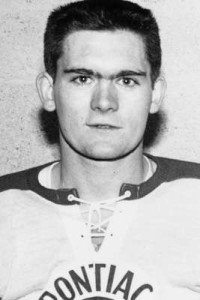
Bruce went back, grabbed his skates, which he always left at the rink, and did the game, and things progressed from there. Shortly after that, during a local intermediate game, he wasn’t playing due to a minor injury, and was asked to replace a linesman who was hurt. He became the ‘local linesman’ for Milton and soon was refereeing full-time.
Refs worked year-to-year
All three agreed that there was no formal method of evaluating an official’s work. They basically worked year-to-year. At the end of each season, they would be called to the referee-in-chief’s office (at that time Scotty Morrison) and offered a contract for the next season. If the league didn’t want them back, they were simply called or sent a letter advising them to seek employment elsewhere.
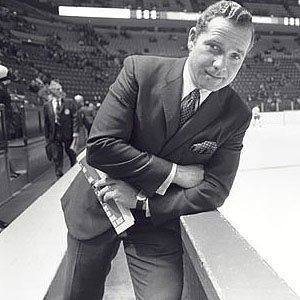
Bryan Lewis said that is one of the biggest changes between those years and today. These three men were instrumental in forming the National Hockey League Officials’ Association to improve the lot of the league’s on-ice staff.
Now with technology and every game being televised, referees are often questioned immediately after a game by supervisors, and some times during the game between periods. The accountability for officials is much greater today.
Did Chief referee order favouritism?
The referees were asked about former official Dalton MacArthur’s allegations that he had been instructed by the referee-in-chief Voss to take it easy on certain teams in 1960.
Ron Wicks worked with Dalton and gave this explanation: “I wasn’t there when it happened but I would submit that Carl Voss would say, ‘Make sure you call good penalties on both teams.’ I knew both of them very well, admired them both. That’s how I would read it.”
Physical altercations with team management
Wicks was working as a linesman in the game in Chicago in 1961 when Montreal Canadiens coach Toe Blake ran onto the ice and punched MacArthur. Blake was fined $2,000 for the act, but was not suspended.
Wicks: “Quite candidly, Toe should have been suspended. But Montreal had won five Stanley Cups…whatever.”
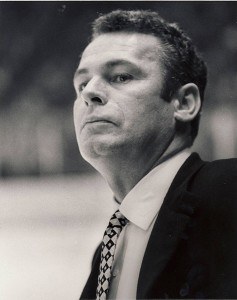
Bruce Hood also spoke about a physical altercation he had with Larry Regan, the first General Manager of the Los Angeles Kings. Regan approached Hood in a hallway leading to the officials dressing room and engaged him in a wrestling match. Bruce said that all Regan was trying to do was to stir up some controversy for the fledgling NHL franchise, to drum up some business, so to speak. Attendance was poor in the beginning and this was his idea on how to get fans into the building.
The “Good Friday Massacre”
Bruce Hood was the referee during the “Good Friday Massacre” game between the Montreal Canadiens and Quebec Nordiques on April 20, 1984. Late in the second period of that game between those two bitter rivals, a brawl broke out that saw both benches empty with virtually everyone on the ice engaged in a fight. With the general melee going on Bruce stood back and asked himself, “How the &%#$@ am I going to pick the players who should be in the box, how am I gonna do that?”
Bruce explained: “The backup referee was Andy Van Hellemond. He’s sitting up in the stands, he’s got a pencil and a pad and he was writing down all the incidents that took place. He comes into the dressing room and we sit down and I said, ‘yeah, that’s right, and that’s right and that’s right.’ And I gave it to the official scorer verbatim. I said, here it is. And he said, yeah, that’s good.
“The problem was, there was, I think, four players on one team and four on the other, four or five, gone, game misconducts. But nobody went and told the teams. That’s why we had a living replay at the start of the third period. The players that had been thrown out and had had a pretty good set-to at the end of the period, they went at it again.”
Bruce was asked why he threw out Peter Stastny and said (jokingly) “Well I didn’t like him from a few weeks before,” and he added a big laugh.
Who is the greatest player?
A question upon which they all agreed was about who they thought the greatest player of all time is. Without hesitation, each of them said it was Bobby Orr.
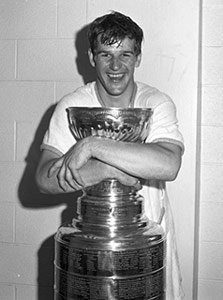
Bryan Lewis explained his viewpoint: “This might be the only time all three of us will agree, in terms of Bobby Orr. And I use it from a couple of perspectives. Oshawa went to Boston (in 1965) to play Niagara Falls Flyers in a league game. I got to go down there and referee that game. It was the first time I had been on a big, huge jet, to referee that game, because it was a league game. They did it for one purpose, to showcase Bobby Orr. And when I think about then, and from where he was then to what he became, I can’t think of anybody, and this is with all due respect to Wayne, and to Lemieux’s and those people of that era that we would be familiar with, in terms of overall change of the game… I played defence, you used to get to the blue line or the red line and shoot it in. You would see Orr down in front of the net, the next thing he was the last guy back backchecking. So I say, he changed the game.”
Who was the toughest player?
They all agreed on the toughest player they had to deal with.
Ron Wicks: “You had to watch a guy like Wayne Cashman. He was a pretty good fighter but he was a little (indicates a little crazy) bit on the edge. And if somebody got him going…look out!
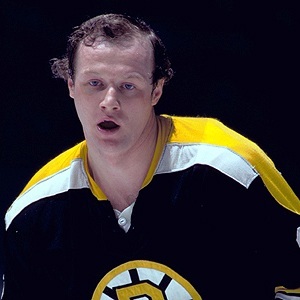
“I remember one night a player in Atlanta took a run at Bobby Orr, and Bobby had just been in for about his eighth knee operation. Cash had him against the boards. He spun his stick and said ‘you try that again and I’ll take both your f’ing eyes out one at a time.’ And on the way out he says ‘And I might take a referee too.’
“I said ‘thanks very much’ and he whacked me on the ass and away he went. You had to deal with a guy like that, but he was, and now that he’s quit drinking, he’s a great guy.”
Bryan Lewis: “A real quick Cashman story: One day coming off the ice, he says ‘Some day I’ll cut your %$@!& eyes out with my stick.” You know what the fear was? You thought some day he might be the guy that would do it.”
Two refs, and replay
All three said that they like the two-referee system, that it was necessary in today’s game. That is because the game is faster, and with the elimination of the red line, it is impossible for one man to keep up with the play now.

Another change the panel likes is the use of instant replay. Bruce Hood commented on that:
“The guys nowadays, not only with the two-referee system but having access to seeing a replay, I think that’s wonderful. I said, even when we had one referee, we should have had use of replay for the referee himself. Not go back to Toronto, or where ever. Step off the ice, take a look at what has just transpired, because you see 85 % of it, or maybe you know 100 % right, but you can go look at that screen and right there verify what you saw and make the call. But they never went along with that. They do in football and in basketball but not in hockey. Replay is wonderful.”
For over 90 minutes the discussion went on about a myriad of subjects, too numerous to discuss here. It was a wonderful night of nostalgia and hockey insight with three most gracious guests at a fantastic venue. It’s no surprise why these three men have such respect among former NHL players.
One thing today we fail to realize, the referee in those days before replay, and all the technology we have now, is that in the days of Hood, Wicks, and Lewis, they were the final authority. What they said WAS the law. While many may have though otherwise, at the end of the day, they were always right.